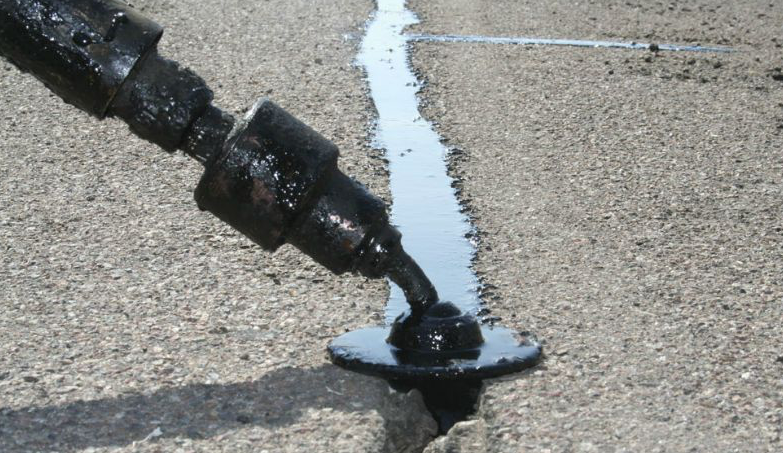Elevate Safety and Charm: Angled Parking Lot Solutions with Asphalt Sealing
Elevate Safety and Charm: Angled Parking Lot Solutions with Asphalt Sealing
Blog Article
Warm Mix Asphalt: A Lasting Remedy for Sidewalk
Warm Mix Asphalt (HMA) has emerged as a leading lasting selection for pavement options, providing a myriad of innovative modern technologies and environmental advantages. As the demand for environment-friendly construction techniques grows, checking out the subtleties of HMA's sustainability can provide important insights into the future of sidewalk solutions.
Ecological Benefits of Hot Mix Asphalt
:max_bytes(150000):strip_icc()/barricade-tape-sealed-driveway-big-56a583145f9b58b7d0dd3d87.jpg)
Additionally, Hot Mix Asphalt aids to mitigate metropolitan warm island impacts. Its dark shade soaks up sunlight, reducing the amount of heat reflected back into the ambience compared to lighter-colored pavements. This can decrease ambient temperature levels in city areas, reducing the need for cooling and ultimately lowering energy consumption.
Furthermore, Warm Mix Asphalt adds to enhanced stormwater monitoring. Its porous nature permits water to recharge and penetrate the pavement groundwater supplies, decreasing runoff and the threat of flooding. These environmental benefits make Hot Mix Asphalt a sustainable choice for paving roadways and freeways.
Energy Effectiveness in HMA Production
Is energy efficiency a crucial element in the manufacturing of Hot Mix Asphalt (HMA)? Power plays a substantial role in the manufacturing of HMA, impacting both cost and ecological sustainability. One essential aspect of energy performance in HMA manufacturing is the use of cozy mix asphalt (WMA) innovations.
Additionally, developments in plant innovations have resulted in more energy-efficient HMA production processes. Modern plants are created with attributes like recycled asphalt sidewalk (RAP) processing capabilities, efficient heater systems, and enhanced insulation, all adding to power savings. By maximizing power usage in HMA manufacturing, the market can reduce its carbon impact while keeping high-grade sidewalk products. Power effectiveness is, consequently, a vital consideration in guaranteeing the sustainability of Hot Mix Asphalt production.
Recyclability of Warm Mix Asphalt
The recyclability of Warm Mix Asphalt (HMA) is an essential aspect of its sustainability and lasting ecological influence. HMA is among the most recycled materials in the USA, with over 100 million tons of redeemed asphalt pavement (RAP) being reused annually in new pavement building and construction. Recycling HMA provides a number of ecological benefits, such as reducing the demand for virgin products, reducing energy usage during production, and lowering the quantity of waste sent to land fills.
The procedure of reusing HMA entails milling the existing pavement, crushing it right into smaller pieces, and blending it with new aggregate and asphalt binder to develop a recycled mix. This recycled mix can typically perform in addition to or perhaps far better than standard HMA, while calling for fewer resources and producing lower greenhouse gas emissions. By integrating RAP into brand-new pavement jobs, roadway companies can preserve natural sources, decrease costs, and decrease the ecological impact of road building and maintenance tasks. In general, the recyclability of HMA plays a significant duty in promoting lasting methods within the pavement market.

Long-Term Performance of HMA
Asphalt pavements show sturdiness and strength over a prolonged period, mirroring the lasting efficiency of Warm Mix Asphalt (HMA) In addition, innovations in HMA modern technology, such as the use of polymer-modified binders and cozy mix asphalt, have better boosted the durability and durability of HMA sidewalks. By focusing on high quality building and maintenance methods, HMA continues to prove itself as a sustainable and cost-effective solution for lasting pavement infrastructure.

HMA: Longevity and Sustainability
Showing both toughness and sustainability, Hot Mix Asphalt (HMA) has come to be a keystone in the construction of resilient sidewalk facilities - regrading. HMA's longevity comes from its capacity to withstand hefty lots, severe climate condition, and high website traffic volumes, making it a trusted option for roads, freeways, and airport terminal runways. The make-up of HMA, which commonly consists of accumulations, binder, and filler, plays a crucial role in boosting its long life and resistance to use and tear
Moreover, HMA's sustainability lies in its recyclability and energy-efficient manufacturing procedure. home The capability to recycle redeemed asphalt sidewalk (RAP) in new HMA blends reduces the need for virgin materials and lessens the environmental impact of sidewalk construction and upkeep. Furthermore, the power effectiveness of creating HMA exists in its reduced mixing temperature levels compared to other sidewalk products, resulting in minimized energy usage and greenhouse gas emissions.
Conclusion
Finally, hot mix asphalt (HMA) supplies a lasting remedy for sidewalk with its ecologically friendly characteristics. HMA's recyclability, energy efficiency in manufacturing, and long-term resilience make it an environment-friendly selection for road building and construction. By conserving natural sources, minimizing waste, and decreasing greenhouse gas emissions, HMA plays a crucial role in advertising sustainability in infrastructure development. Its capacity to alleviate metropolitan heat island results additionally highlights its value in producing environmentally aware and resilient pavement systems.
HMA is one of the most recycled materials in the United States, with over 100 million loads of redeemed asphalt pavement (RAP) being recycled each year in new sidewalk building and construction.The process of reusing HMA entails crushing the existing pavement, crushing it right into smaller sized pieces, and mixing it with new aggregate and asphalt binder to create a recycled mix.Asphalt sidewalks demonstrate durability and resilience over an extensive duration, reflecting the long-term efficiency of Hot Mix Asphalt (HMA) Additionally, developments in HMA innovation, such as the usage of polymer-modified binders and warm mix asphalt, have actually even more improved the sturdiness and longevity of HMA sidewalks. The ability to check it out reuse redeemed asphalt pavement (RAP) in new HMA blends minimizes the demand for virgin products and reduces the ecological impact of pavement her response building and construction and upkeep.
Report this page